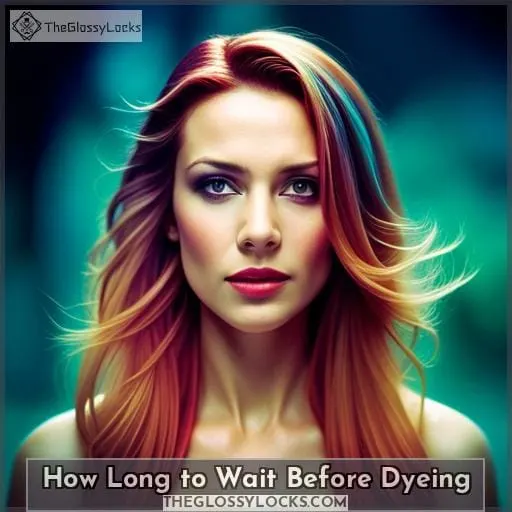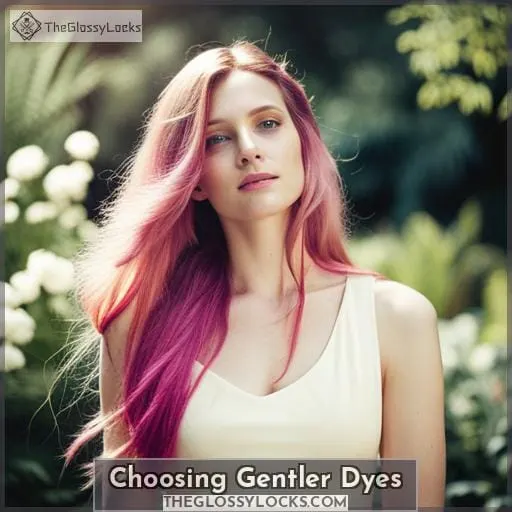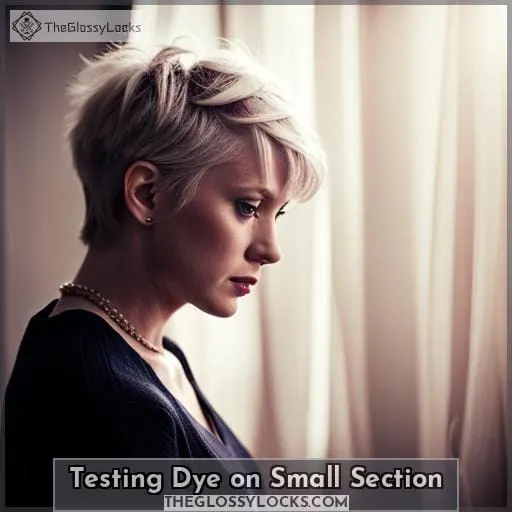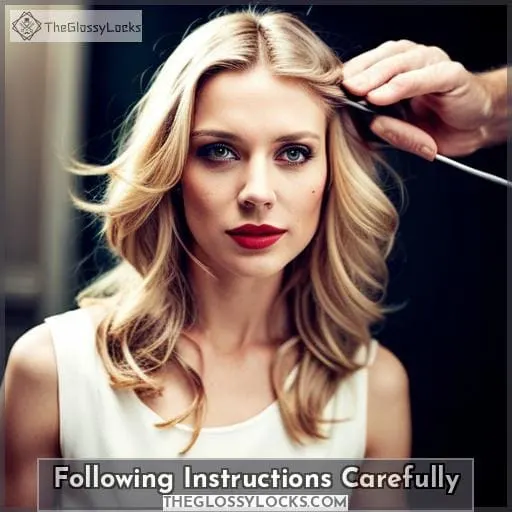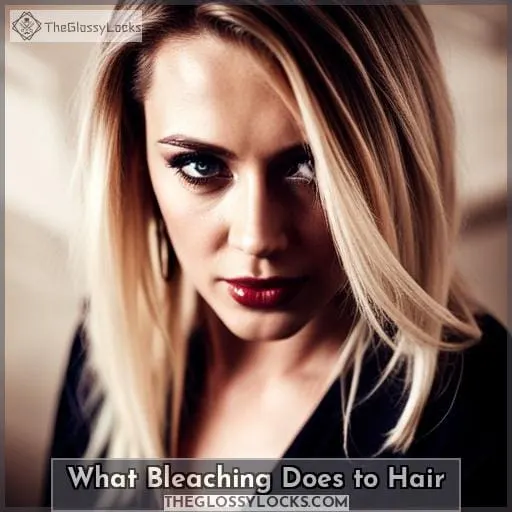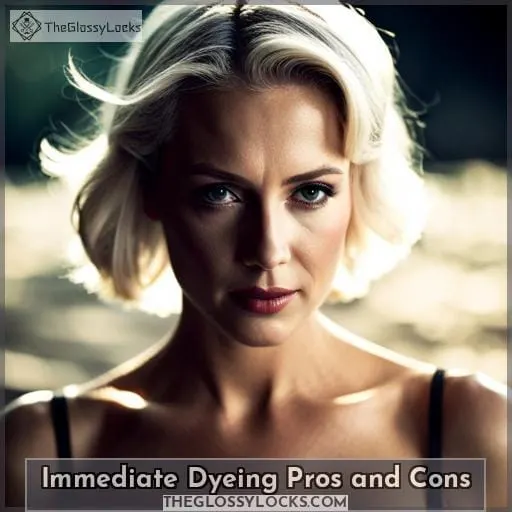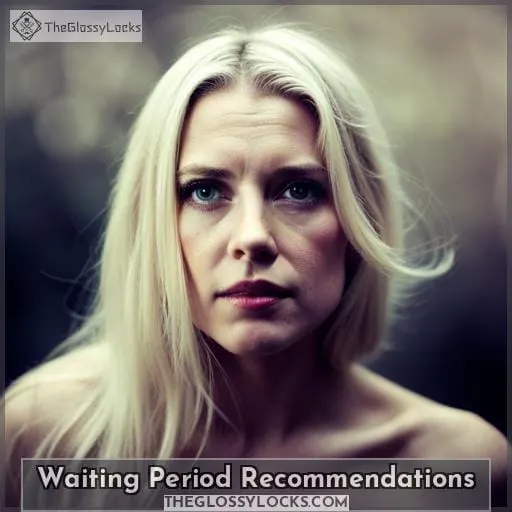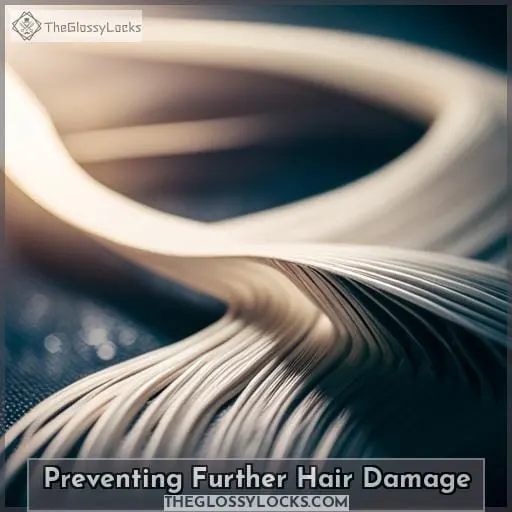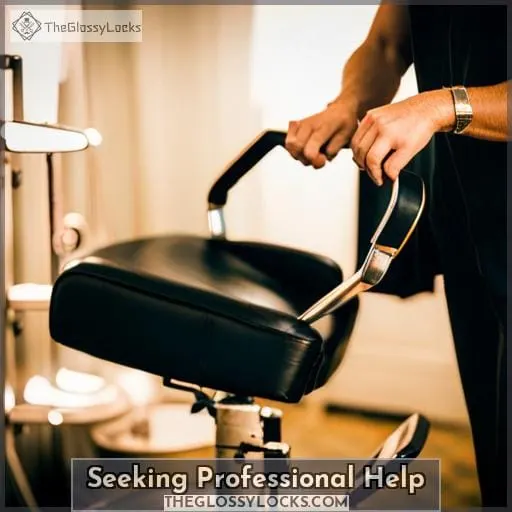This site is supported by our readers. We may earn a commission, at no cost to you, if you purchase through links.
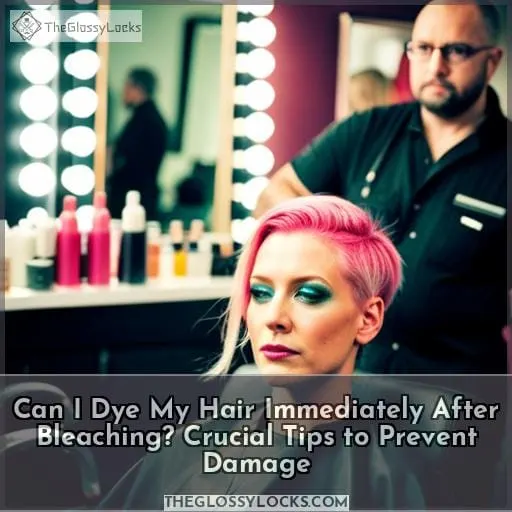
I’ve done my fair share of rainbow hair experiments, so trust me when I say: patience pays off.
Giving those fragile strands a break before dyeing lets them heal so you can really make that color pop.
Take it from this styling pro: hold off on dye for a few days after lightening, then you can transform your hair without further damage.
Now that’s hair-raising advice!
Table Of Contents
- Key Takeaways
- How Long to Wait Before Dyeing
- Preparing Hair Before Dyeing
- Choosing Gentler Dyes
- Testing Dye on Small Section
- Following Instructions Carefully
- What Bleaching Does to Hair
- Immediate Dyeing Pros and Cons
- Waiting Period Recommendations
- Preventing Further Hair Damage
- Seeking Professional Help
- Frequently Asked Questions (FAQs)
- How soon can I re-dye my hair after an initial dyeing session?
- What at-home products can help improve the look and feel of hair between salon appointments?
- How do I determine if a semi-permanent or demi-permanent dye is right for me?
- What steps should I take if I experience skin irritation during a hair dye patch test?
- What types of brushes and combs are best to use on color-treated hair?
- Conclusion
Key Takeaways
- Wait 1-6 weeks before applying dye depending on damage level to allow hair to recover.
- When ready to dye, choose gentle, conditioning formulas like semi-permanent or demi-permanent dyes.
- Follow all dye instructions precisely. Conduct a strand test first to check for allergies and preview color results.
- Post-dye, limit heat styling and regularly trim split ends. Use leave-in treatments with oils for protection.
How Long to Wait Before Dyeing
When you’re deciding how long to wait before dyeing your hair after bleaching, you’ll need to assess the current condition of your strands and the shade of dye you plan to use. Having patience and allowing an optimal waiting period benefits hair health immensely after the intense bleaching process.
Aim to restore moisture balance and repair damage through deep conditioning treatments during this post-bleach interval.
The waiting duration depends significantly on your hair’s level of dryness and brittleness. For hair in extremely rough shape, hold off on dyeing for at least 6 months to enable thorough restoration. Moderately damaged strands may require 4-5 weeks of intensive conditioning to bounce back.
If opting for darker dyes, you could potentially dye hair with minimal damage after only 1-2 weeks. Always perform a patch test regardless to check the dye’s impact and limit potential damage.
Monitoring your bleached hair’s rejuvenation closely allows you to time the dye job appropriately for enhanced results and healthier strands moving forward.
Preparing Hair Before Dyeing
Before you color recently bleached hair, it’s crucial to restore and reinforce strands.
Use a protein-packed preparatory filler to equalize porosity and deeply condition to hydrate.
Doing so will help the hair better receive color for maximized vibrancy and longevity while minimizing potential damage.
Protein Fillers
Commonly, you’ll want to use protein fillers before dyeing to help repair damage and prepare hair for even color application.
They reinforce hair structure.
They increase moisture retention.
They even out porosity.
They boost shine and vibrancy.
Using protein-rich treatments pre-coloring is crucial to restore your strands, allowing better dye uptake for maximized results.
Deep Conditioning
You’ll want to deeply condition your hair regularly before dyeing to help restore moisture and repair damage.
Conditioning techniques are crucial for hydration importance, moisture retention, and repair methods.
Deep conditioning treatments nourish the hair strands from within, providing essential nutrients and restoring strength.
This step is vital in preparing your hair for the color application process while ensuring optimal results and promoting overall hair restoration.
Incorporating deep conditioning into your regular hair care routine will aid in maintaining vibrant color while keeping your locks healthy and luscious.
Choosing Gentler Dyes
When opting to dye hair immediately after bleaching, it’s crucial you select a gentle, conditioning formula.
Consider kinder semi- or demi-permanent dyes enriched with oils over harsher permanents to minimize dryness and breakage.
Performing a patch test with the gentler dye will allow you to safely evaluate its impact on freshly bleached strands before full application.
Timing Dye Application
Now let’s delve into the next step: applying the dye at the right time and selecting gentler dyes to minimize damage.
- Semi-permanent dyes with oils nourish strands.
- Demi-permanent colours deposit pigment gently.
- Low-volume developer mixes soften impact.
- Ammonia-free formulas prevent dryness.
- Weekly gloss treatments enhance colour and condition.
Timing matters. Assessing hair’s health and desired results guides ideal wait times post-bleaching before dyeing.
Dye Selection Considerations
The dye you choose can also impact how damaged your hair gets, so opt for milder semi or demi-permanent dyes that tend to be less harsh on bleached strands.
Semi-permanent options deposit color without lifting original pigment, causing less damage, while demi-permanent dyes only partially penetrate to deposit color.
Carefully selecting gentler dye options better supports desired color results without compromising moisture balance or requiring extensive protein repair between blonde and brown.
Minimizing Hair Damage
Opting for milder semi or demi-permanent dyes helps reduce additional damage when dyeing after bleaching. These gentler formula options infuse strands with nourishing oils and proteins while depositing soft color.
Deeply condition bleached hair beforehand too for extra moisture. Applying a protein-packed treatment first provides reinforced structural repair as well.
Carefully follow all instructions for any at-home dye you choose post-bleaching and perform a patch test beforehand on a small section to gauge impact.
Testing Dye on Small Section
Before dyeing all your hair, test the dye on a small section to assess its impact.
Select a one inch square section of hair close to your face.
Following box dye instructions, apply a small amount of color to the strand test section only and time according to directions.
This simple step reveals key information on potential allergic reactions and lets you preview final results based on your hair’s pigment absorption capacity and porosity.
Strand tests also check skin sensitivity, an essential safeguard to avoid potential irritation or burning before full dye application.
By performing a quick color patch test, you minimize the risk of being stuck with an unwanted shade or terrible reaction across your whole head.
It takes little time, requires minimal dye, yet provides the necessary insight you need to dye your strands successfully.
Following Instructions Carefully
You need to carefully follow the instructions when dyeing your hair to get better results and reduce damage.
- Read instructions thoroughly before starting the dyeing process.
- Note required timing for each step, like leaving dye on for 30 minutes.
- Follow mixing directions precisely to activate and apply dye properly.
- Carefully apply dye only to regrowth areas first for effective color correction.
Understanding procedures through expert guidance enables effective maintenance and damage prevention when dyeing post-bleaching. Following instructions equips you to achieve the desired color outcome while minimizing further hair trauma.
With precise adherence, you can correct color, nourish strands, and reduce drying or breakage.
What Bleaching Does to Hair
When you bleach hair, it breaks down the hair’s natural pigment bonds and damages the protective cuticle layer, leading to permanent alterations as it strips out the original coloring.
Bleaching oxidizes melanin pigments, fracturing disulfide bonds in the cortex to extract color.
Bleaching also compromises the cuticle layer, causing uneven porosity and dry, fragile strands prone to breakage. Without the cuticle’s protection, moisture escapes rapidly from the cortex, preventing hair from bouncing back post-bleaching.
While trimming can remove damaged portions, bleaching precipitates lasting changes, necessitating special care.
Immediate Dyeing Pros and Cons
When it comes to dyeing immediately after lightening, there are positives and negatives to consider. While it may seem convenient and cost-effective to combine services, compromising the integrity of strands too soon can cause more harm than good.
Let’s weigh the potential benefits against possible damage when deciding if same-day dyeing post-bleach makes sense for your hair.
Pros
Conversely, what are the potential benefits of dyeing hair immediately after bleaching?
You’re able to achieve quick results, intense color payoff, and potentially save on cost when combining services.
Opting for same-day bleaching and dyeing allows you to realize intensely vibrant, long-lasting color in one efficient salon visit.
Taking this consolidated approach also makes the process more cost-effective by minimizing trips to the stylist.
The freshly opened cuticle post-lightening lets color deeply permeate for enhanced pigment deposit and retention.
Overall, same-day procedures yield intensely saturated shades with time and money savings.
Cons
Hair brittleness and increased breakage risk counteract the time- and cost-savings of immediate post-bleach dyeing.
Though combining services saves money upfront, compromised integrity leads to split ends requiring trims, minimizing length retention.
Color also fades faster without a waiting period for strand recovery.
Postponing four weeks enables thorough conditioning for better dye uptake, even application, and longevity.
Adhering to this timeline prevents wasting product and money on lackluster color requiring repeat touch-ups.
Prioritize hair health first. Vibrancy comes second.
Waiting Period Recommendations
You’ll want to let your bleached hair rest for 1-6+ months before dyeing, depending on the level of damage.
If your hair is extremely fragile post-bleach, hold off on dye for at least 6 months to allow your strands to recover strength and moisture.
For less damaged hair, wait 1-2 weeks before applying permanent color or 4-5 weeks before fashion shades.
This waiting period enables proper hair regeneration and improves color absorption for better dye results.
During this post-bleach phase, nurture your hair with weekly deep conditioning and leave-in treatments to restore elasticity.
Once your hair regains its health, you can dye with less risk of breakage or dullness.
Be patient – this interim care sets the stage for the vibrant, smooth color you crave.
Preventing Further Hair Damage
To prevent further hair damage after bleaching, limit heat styling and brush hair gently with a wide-tooth comb.
Protect strands by:
- Using leave-in treatments with natural oils
- Avoiding additional chemical processing
- Letting hair air dry instead of heat drying
- Protecting hair from sun exposure
- Getting trims regularly to snip split ends
Getting a professional consultation can provide personalized guidance on nurturing fragile, post-bleach hair. With some patience and the proper preparations, freshly lightened hair can still achieve your dream color.
Prioritize damage control first before considering any coloring service. Your hair’s health comes first.
Seeking Professional Help
Although you can dye your hair immediately after bleaching, seeking professional help is advisable since stylists can properly assess hair damage and recommend suitable coloring services based on your hair’s condition.
As a licensed cosmetologist with over a decade of experience, I can’t stress enough the value of getting a consultation before deciding whether to dye post-bleach. My expert insights allow me to examine the current state of your strands and determine the ideal timeframe and products for coloring without causing further damage.
I can suggest customized options based on factors like porosity levels, tone goals, lifestyle and more.
At my salon, our elite colorists provide guidance to create the most flattering look for your hair while safeguarding its health.
Let’s care for those precious locks. With our advice, you can achieve gorgeous color Results and maintain the integrity of your hair long-term.
Frequently Asked Questions (FAQs)
How soon can I re-dye my hair after an initial dyeing session?
Wait at least two weeks after initial coloring before reapplying dye for best results. This allows hair to recover and strengthen while the color sets in properly. Otherwise you risk damaging strands and dulling tone.
What at-home products can help improve the look and feel of hair between salon appointments?
To improve your hair between salon appointments, try using:
- Colorful Protein Filler Hairdressers Color Insurance for longer-lasting color and protection.
- Aveda Damage Remedy BB Equalizing Solution strengthens and repairs damaged hair before chemical services.
- L’Oreal Paris Superior Preference Fade Defying Shine Permanent Hair Color Dark Brown provides vibrant, fade-defying color at home.
How do I determine if a semi-permanent or demi-permanent dye is right for me?
You’re craving change. Let your hair lead the way.
What steps should I take if I experience skin irritation during a hair dye patch test?
If skin irritation occurs during a patch test, immediately wash the area with cool water and a mild cleanser. Avoid scratching, apply a hydrocortisone cream, and let your stylist know so they can evaluate ingredients and recommend less irritating dye options.
What types of brushes and combs are best to use on color-treated hair?
Use seamless combs and gentle boar bristle brushes for color-treated hair.
They smooth strands without snagging or pulling, preventing damage.
Plastic bristles can be too harsh.
Conclusion
Ultimately, patience is a virtue when it comes to dyeing bleached hair.
I know you’re eager to make that bold color change, but give those fragile strands 2-4 days to heal before applying dye. This allows the cuticles to close and prevents further damage, enabling the color to better grab and pop.
When you do apply dye, carefully follow instructions and test on a small section first.

